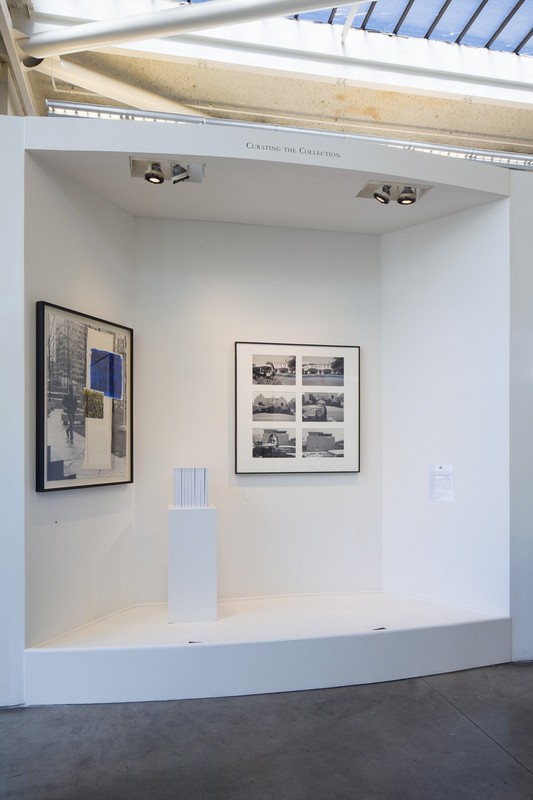Curating the Collection: Jesi Khadivi
26 Mar - 20 Apr 2013

Working Class Hero, installation view, 2013. Courtesy the CCA Wattis Institute for Contemporary Arts. Photo by Johnna Arnold Photography.
CURATING THE COLLECTION: JESI KHADIVI
Working Class Hero
26 March - 20 April 2013
Working Class Hero
Allan Sekula, Mungo Thomson, and Ian Wallace
Working Class Hero presents works from the Kadist Foundation’s 101 collection that hone in on three sites of value production: the home, popular media, and the street. With a touch of deadpan humor, the works in this exhibition conflate conceptual and documentary approaches to the image, articulating complex relational systems through the tropes of familiar cultural forms.
Allan Sekula’s photographs often focus on the “imaginary and material geographies” of advanced capitalism.1 In his series California Stories..., Sekula depicts a makeshift notational system that articulates the relationship between class status and geographic elevation. In lieu of graphs or textual evidence, Sekula instead conveys economic disparities using his own hands, proposing a personal relationship to demographic data.
Mungo Thomson’s ten-volume box set The White Album contains a bootleg compendium of all of the advertisements published in the magazine Artforum from 1970-1979. Housed in deceptively simple packaging, evoking both minimal sculpture and the Beatles’ eponymous record, The White Album distills a counter history of art criticism in the 1970s through a series of artist books.
Vancouver artist Ian Wallace’s study for his series My Heroes in the Street provides an oblique passage between the representational systems proposed by Sekula and Thomson. In this series, Wallace places the individual, which the artist deems a “hero,” at the core of his work. While this work also presents an intersection of material and imaginary systems, the artist chooses to emphasize the individual’s relationship to the street as the fulcrum that links, in his words, “all the forces of society and economics.” In Study for my Heroes on the Street (Stan), Wallace depicts fellow photo-conceptualist, Stan Douglas, strolling through an empty public plaza. The composition mines the archetype of the artist-flaneur who negotiates a “forest of symbols,” while simultaneously proposing ruptures and empty spaces in the urban landscape through applying strips of canvas on an otherwise representational photograph.
Works in the Exhibition:
Allan Sekula
California Stories Attempt to Correlate Social Class with Elevation Above Main Harbor
Channel (San Pedro, July 1975), 1973
photograph
Mungo Thomson
The White Album, 2008
mixed media
Ian Wallace
Study for my Heroes in the Street (Stan), 1986
collage
Working Class Hero was curated by Jesi Khadivi.
*Please note that the Mary Augustine Gallery is located in CCA's main building on the San Francisco campus, and not at the CCA Wattis Institute's new location on Kansas Street.
All installation images for Working Class Hero were photographed by Johnna Arnold.
Allan Sekula, "Notes for an Exhibition Project" (for Witte de With, Rotterdam), 1992, unpublished manuscript (xerox), p. 1 ↩
Working Class Hero
26 March - 20 April 2013
Working Class Hero
Allan Sekula, Mungo Thomson, and Ian Wallace
Working Class Hero presents works from the Kadist Foundation’s 101 collection that hone in on three sites of value production: the home, popular media, and the street. With a touch of deadpan humor, the works in this exhibition conflate conceptual and documentary approaches to the image, articulating complex relational systems through the tropes of familiar cultural forms.
Allan Sekula’s photographs often focus on the “imaginary and material geographies” of advanced capitalism.1 In his series California Stories..., Sekula depicts a makeshift notational system that articulates the relationship between class status and geographic elevation. In lieu of graphs or textual evidence, Sekula instead conveys economic disparities using his own hands, proposing a personal relationship to demographic data.
Mungo Thomson’s ten-volume box set The White Album contains a bootleg compendium of all of the advertisements published in the magazine Artforum from 1970-1979. Housed in deceptively simple packaging, evoking both minimal sculpture and the Beatles’ eponymous record, The White Album distills a counter history of art criticism in the 1970s through a series of artist books.
Vancouver artist Ian Wallace’s study for his series My Heroes in the Street provides an oblique passage between the representational systems proposed by Sekula and Thomson. In this series, Wallace places the individual, which the artist deems a “hero,” at the core of his work. While this work also presents an intersection of material and imaginary systems, the artist chooses to emphasize the individual’s relationship to the street as the fulcrum that links, in his words, “all the forces of society and economics.” In Study for my Heroes on the Street (Stan), Wallace depicts fellow photo-conceptualist, Stan Douglas, strolling through an empty public plaza. The composition mines the archetype of the artist-flaneur who negotiates a “forest of symbols,” while simultaneously proposing ruptures and empty spaces in the urban landscape through applying strips of canvas on an otherwise representational photograph.
Works in the Exhibition:
Allan Sekula
California Stories Attempt to Correlate Social Class with Elevation Above Main Harbor
Channel (San Pedro, July 1975), 1973
photograph
Mungo Thomson
The White Album, 2008
mixed media
Ian Wallace
Study for my Heroes in the Street (Stan), 1986
collage
Working Class Hero was curated by Jesi Khadivi.
*Please note that the Mary Augustine Gallery is located in CCA's main building on the San Francisco campus, and not at the CCA Wattis Institute's new location on Kansas Street.
All installation images for Working Class Hero were photographed by Johnna Arnold.
Allan Sekula, "Notes for an Exhibition Project" (for Witte de With, Rotterdam), 1992, unpublished manuscript (xerox), p. 1 ↩
